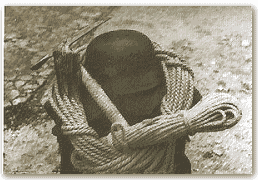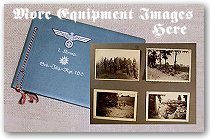|
| The Bergmütze (Mountain Cap)
was the official field cap worn by the Gebirgsjäger. It had high sides
and a short peak. The M43 standard field cap was adopted by the German
Wehrmacht in 1943 for general issue and was based on the Bergmütz
design. The Bergmütze was based on the Austrian Ski cap used during
WW1. This is an Officers cap as it has the piping along the top edge. A
white light cotton cover was used to cover the cap in snow for camouflage. |
|
|
|
| Stahlhelm (Helmet)
.There were camouflage covers which could be reversed to match the surroundings.
The patterns were Splinter/White and Tan water/White. |
|
|
|
| Tropical shorts worn in the Mediterranean theatre.
Worn in Italy, Greece and I have seen an example worn in Crete (although
the standard trouser was more common during this time) |
|
|
|
| Brotbeutel (Bread bag) used for holding food,
a lard container and personal items for the soldier. |
|
|
|
| Bergschuhe (Mountain Boots) Climbing boots used
by mountain troops. Note the heavy sole and the hob nails around the edge
as well as the sole. |
|
|
|
| Feldflasche mit Trinkbecher (field flask with
aluminium drinking cup). This flask has a carbine hook on the reverse side
which clipped onto the Breadbag through a D ring. |
|
|
|
|
|
|
| Snow Goggles and trench art engraved Kochgeschirr.
Carving/engraving appears to be a common way to pass the long hours between
action. Many items were used for carving/engraving including spent
shell cases, canteens etc. Note the unusual pattern of the slots in the
snow goggles for the prevention of snow blindness. |
|
|
|
| Gasmaske and Canister. In case of gas attack,
which never happened. I had read that Hitler never had any intention of
using gas during WW2 as he himself had been under gas attack as a soldier
during WW1. It was common practice for soldiers to discard the mask and
use the canister for the storage of extra items like bandages, food etc. |
|
|
|
| Snow Shoes and instruction manual. These were
made of light wood, cord and leather securing straps. |
|
|
|
| Crampons were attached to the mountain boots
for use on ice. |
|
|
|
| Trench Knife. Used for general cutting of food,
rope and possibly hand to hand combat? It usually was clipped into the
tunic or boot. |
|
|
|
| Koppelschluss and Koppel (Buckle and belt) |
|
|
|
| Pulovermantel (Reversible Parka) This was reversible
to white and for the Gebirgstruppen mouse grey/white was the issue. This
example is the later Tan Water/white pattern with a white reverse side.
They were hooded and contained a heavy blanket type material inside. A
button on the top side of each arm was used to attach identification colour
bands (which changed each day) during winter fighting in the East. |
|
|
|
| Doppelfernröhre (Binoculars) 6x30 |
|
|
|
| Shanzzeug (Entrenching Tool) |
|
|
|
| Piton Hammer used to drive Pitons
into rock surfaces and cracks for rope attachment |
|
|
|
|
|
|
| The Rucksack and a Piton Hammer |
|
| |
| More Additions and Details
to Come |
|













